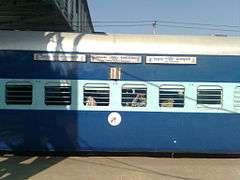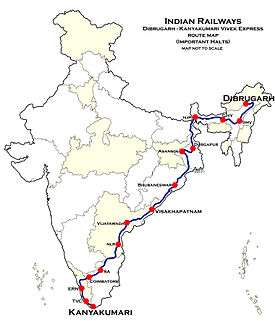Dibrugarh–Kanyakumari Vivek Express
Dibrugarh–Kanyakumari Vivek Express is a weekly Express train of the Vivek Express series the Indian Railways which runs from Dibrugarh in India's north eastern state Assam to Kanyakumari in Tamil Nadu the southernmost state of India. In close to 80 hours the train covers a distance of 4,218.6 kilometres (2,621.3 mi) and traverses through nine states in India.[1] This train currently holds the prestigious record of being the longest running train route in the Indian Subcontinent both in terms of distance as well as time. The train has 56 halts across its route.
 Dibrugarh–Kanyakumari Vivek Express at Guwahati | |||||
| Overview | |||||
|---|---|---|---|---|---|
| Service type | Vivek Express | ||||
| Status | Operating | ||||
| Locale | Assam, Bihar, Nagaland, West Bengal, Jharkhand, Odisha, Andhra Pradesh, Tamil Nadu & Kerala | ||||
| First service | 26 November 2011 | ||||
| Current operator(s) | Northeast Frontier Railway | ||||
| Route | |||||
| Start | Dibrugarh (DBRG) | ||||
| Stops | 58 | ||||
| End | Kanyakumari (CAPE) | ||||
| Distance travelled | 4,219 km (2,622 mi) | ||||
| Average journey time | 82hr 50min | ||||
| Service frequency | Weekly, Saturday | ||||
| Train number(s) | 15905/15906 | ||||
| On-board services | |||||
| Class(es) | Second AC Third AC Sleeper | ||||
| Seating arrangements | Available | ||||
| Sleeping arrangements | Available | ||||
| Catering facilities | Available | ||||
| Baggage facilities | Available | ||||
| Technical | |||||
| Rolling stock | LHB Coaches | ||||
| Track gauge | 1,676 mm (5 ft 6 in) | ||||
| Electrification | Partial | ||||
| Operating speed | 51 km/h (32 mph) | ||||
| |||||
Loco Reversal
The train takes WDM 3A from Dibrugarh & reverses its direction in Durgapur railway station,then it takes a Asansol Jn. based WAP 4 and at last it takes a Visakhapatnam Junction based WDM 3A for completing his journey.
History
Vivek Express are four pairs of Express Trains on the Indian Railways network. These trains were announced in the Railway Budget of 2011-12 by the then Railway Minister Mamata Banerjee. These trains were started to commemorate the 150th birth anniversary of Swami Vivekananda.
Vivek express also holds another place in the history of indian railways, as being the last train to halt its services, when the entire indian railway passenger services came to standstill following the COVID19 pandemic and the subsequent national wide lockdown in March 2020.
Route
Dibrugarh - Kanyakumari Vivek Express joins Dibrugarh in Assam, North-East India to Kanyakumari, Tamil Nadu which is the southernmost tip of Mainland India. The train No:15906 starts from Dibrugarh at 22:45 PM and reaches Kanyakumari at 9:50 AM on the fifth day of journey. In the return direction the train no: 15905 leaves Kanyakumari at 23:00 PM and reaches Dibrugarh at 07:15 AM on the fifth day. The train travels through the states of Assam, Nagaland, West Bengal, Bihar, Jharkhand, Odisha, Andhra Pradesh, Kerala and Tamil Nadu. It passes through important cities such as Tinsukia, Dimapur, Guwahati, Bongaigaon, Alipurduar, Siliguri, Kishanganj, Malda, Rampurhat, Pakur, Durgapur, Asansol, Kharagpur, Balasore, Cuttack, Bhubaneswar, Khordha, Brahmapur, Srikakulam, Vizianagaram, Visakhapatnam, Samalkot, Rajahmundry, Eluru, Vijayawada, Ongole, Nellore, Renigunta, Vellore, Salem, Erode, Coimbatore, Palakkad, Thrissur, Aluva, Ernakulam, Kottayam, Chengannur, Kollam, Thiruvananthapuram and Nagercoil.
Coach composition
Dibrugarh - Kanyakumari Vivek Express Express has 2 Tier, 3 Tier AC coaches, Sleeper class coaches which can be booked in advance. Other second sitting coaches can be boarded with unreserved tickets issued from the counter.
